Combines typically spend up to 10 months of the year stored away in a shed lying idle, before being worked to their limits for the duration of the harvest period.
Once harvest season starts these machines are expected to work optimally, while enduring the unpredictable Irish weather conditions. Given the intense harvesting period, reducing the possible risk of machine downtime is crucial, so it is important that these machines receive a thorough servicing from top to bottom well before entering the field.
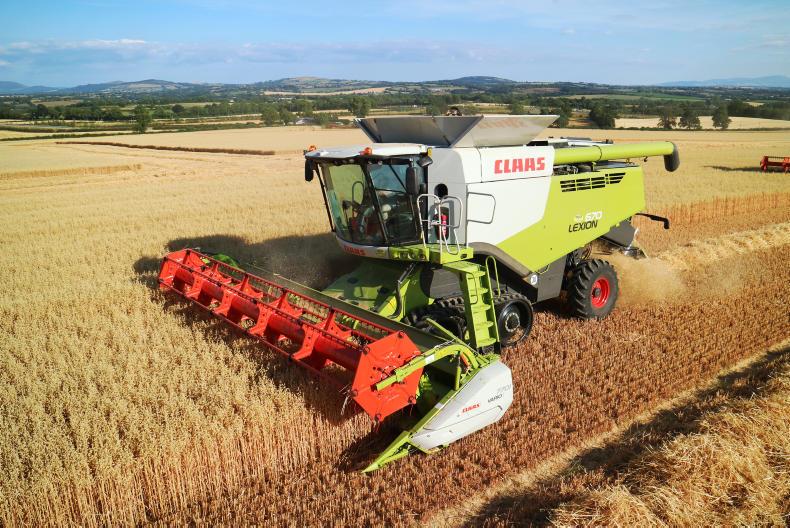
Combines are often pushed to their limits throughout harvest season, so proper machine maintenance is key in ensuring a trouble-free season.
Breakdowns are impossible to eliminate no matter how new or how well maintained the machine is, but practising good, thorough machine maintenance before the season kicks off can greatly reduce the risk of downtime.
Operation
Today, there are mainly three combine types – straw walker machines, rotary machines and hybrid machines encompassing a mix of both technologies. Walker-type machines have evolved from the vintage stationary threshing sets, with the addition of a header, an engine, a transmission and a cab.
All manufacturers have different features and variations of the core design to make their own machines differ from the rest. All these machines are comparable in that they feature a header with a reel and knife auger. From here the auger feeds the elevator at rates up to 3m/s on modern machines, where the crop then enters the primary threshing/separator drum.
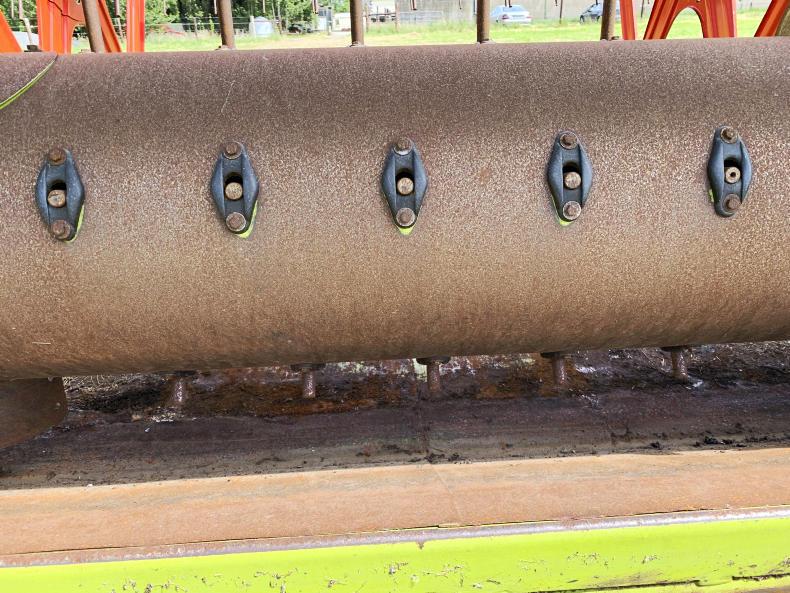
Auger fingers should be intact and not damaged or missing.
After passing through the primary threshing drum, the crop enters the secondary separator drum in many instances.
Combine types
Regardless of combine type, machines differ in how they separate the grains from the straw. Straw walker machines will separate them as the straw climbs the moving walkers. Straw is then ejected out the rear of the combine while grain falls onto sieves to be further cleaned. The shaker shoe separates the grains from the chaff using a fan to blow the light chaff out the rear of the machine, as the grain is transferred to the tank via elevator.
Rotary machines use centrifugal force to remove grains from the straw, so the more crop passing through the combine at any one time, the better the threshing, as the abrasive motion within the rotor removes grains. This is one of the main differences between walker and rotor machines, and a different mentality is needed when operating each one.
Regardless of brand, combines have a lot of moving parts, with multiple types of drive mechanisms. There are several kinds of chains and sprockets, and belts and pulleys using single, double-sided and multiple-banded belts.
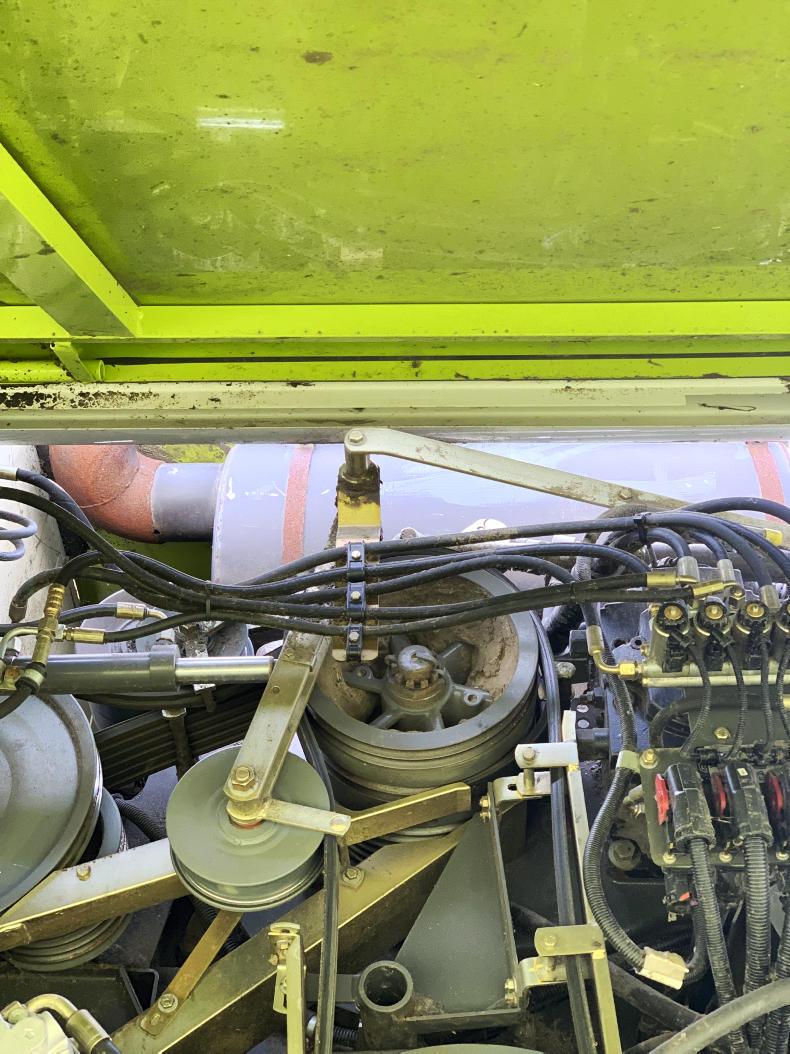
The main pulleys internals here is designed to pull in air and cool the gearbox behind. Dust build up on this as can be seen will affect the cooling effcet.
Bearings and bushings also make up important parts of the machines.
Mechanisms such as slip clutches and hydraulic systems, hydrostatic drives and mechanical shaft drives all work to protect combine machines from overloading, with modern combines relying on more and more electronics such as sensors, solenoids and other electronic devices. And let’s not forget the engine, which can come from several different suppliers. All these individual components need to be maintained to a high standard.
Header and elevator
The header is the first point of contact with the crop, yet is often overlooked. If the header is not set up or properly maintained, this can be an area where losses occur, even before the crop enters the machine.

Headers often take abuse throughout the season so it is important everything is running as it should be.
The drive type, the header chain or belt drive condition and tension should be checked and maintained accordingly. It is a good idea to disconnect the knife bar from the wobble box and ensure it is moving freely and not bent.
If the knife bar is not moving freely, this can lead to damage within the wobble box over time, which creates the shearing-like reciprocating cutting motion. All knife sections should be intact and sharp, as blunt knifes will not cut the crop as clean, leading to loss of grain. Fingers should be in line and knife timing should be checked. Auger fingers located to the centre of the auger should be intact and not worn or missing.
Chaff should be removed from any electrical looms. This is a typical area vermin may target over the winter period and damage cables. All shafts and header connections should be greased daily and in good working order, and any bearings or wearing parts such as skids should be checked before the season starts.
The elevator
Elevator slats should be checked regularly and replaced if bent or damaged. Tension should be checked next; ideally the third bar in should be almost touching the elevator housing. Just below the elevator is the stone trap door, which ideally should be opened and emptied on a daily basis.
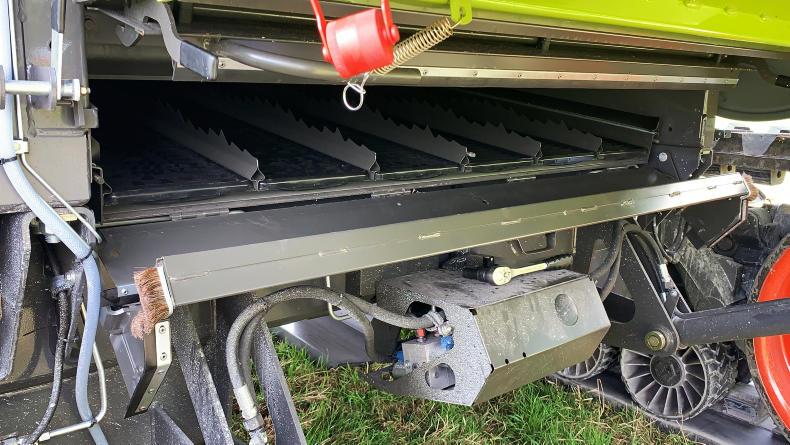
Stone traps should be emptied daily.
Engine and drivetrain
The engine should be serviced at the recommended intervals or annually. This includes diesel filters, oil filters, air filters, as well as daily checking of all fluid levels.
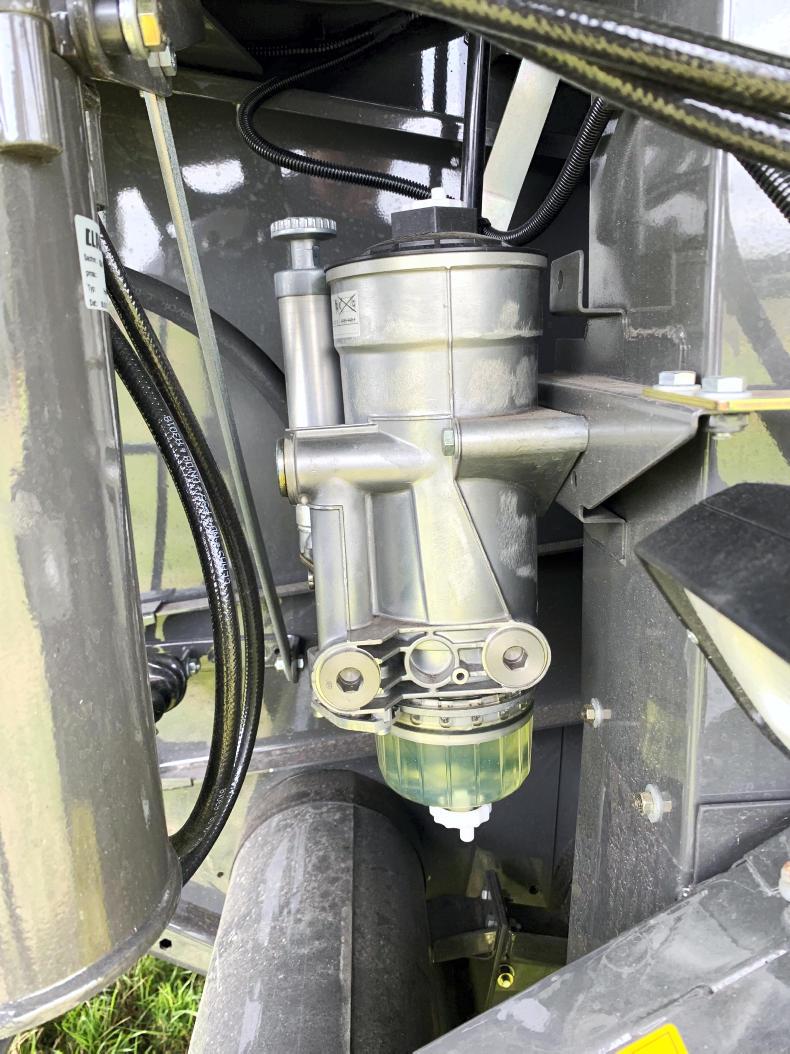
The engine should be fully serviced before the season. All filters should be changed, as dirty diesel filters for example can hinder engine preformance.
All drive pulleys and chains should be checked throughout for wear and tension, and tensioning or replacing should occur if necessary. These chains include grain tank elevator chains, return elevator chains and unloading system chains. Chains should be at the correct tension, the operator should be able to move the chain over and back on the sprocket, no tighter or no looser. It goes without saying that all chains and bearings should be receiving sufficient lubrication throughout the harvest period. The entire area should be blown down using an airline daily during the harvest, as dust and chaff build up easily during these dry dusty working conditions.
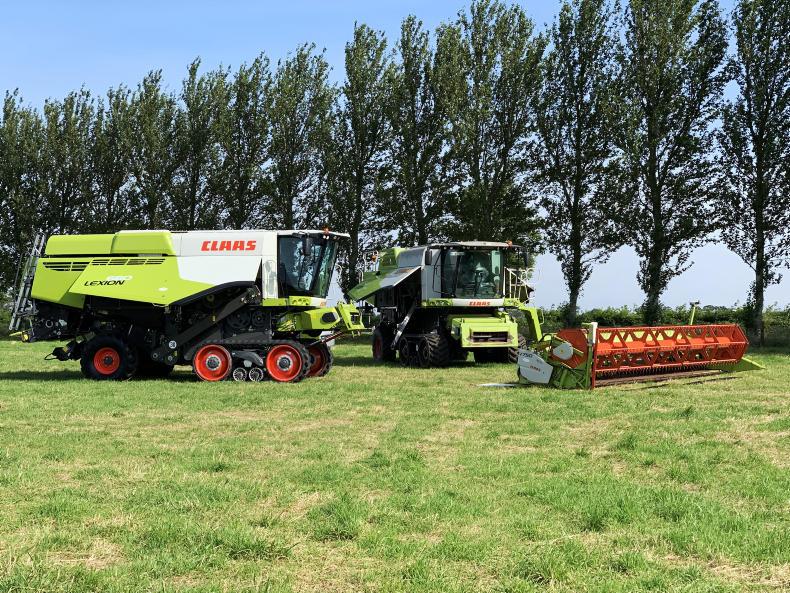
Combines should be blown down each evening or morning ahead of the next days work.
Some components or pulley wheels have an internal shape similar to a propeller to move air, and thus cool other components. These areas can build up with dust over time, and therefore need to be kept clean so that areas of the combine are receiving adequate cooling.
General maintenance
General machine maintenance such as checking the wheel or track condition, should be examined before harvest starts.
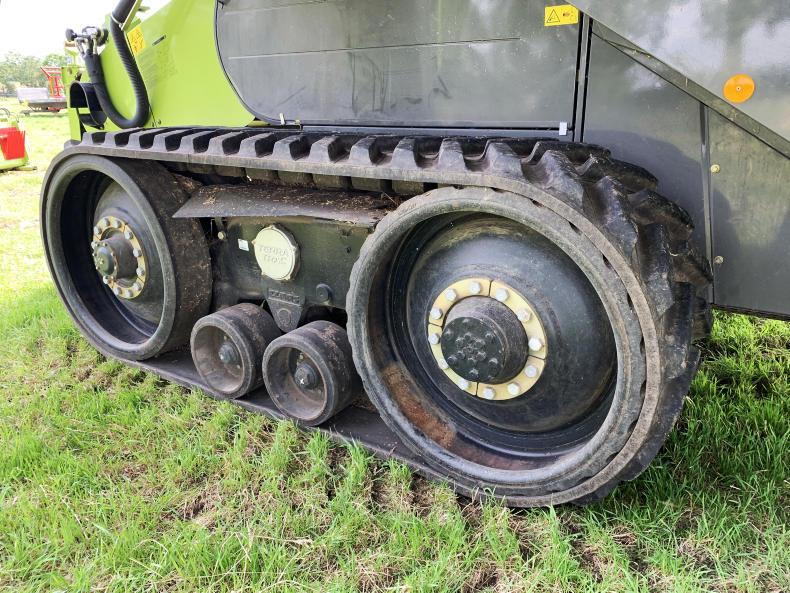
Combines fitted with tracks should be checked for wear and that track tension is as guided.
Tracked machines should have track tension checked and idler wheels given a once-over for excessive wear. Wheeled combines should be checked for cuts or damaged tyres, while wheel nuts should be torqued to manufacturers’ guidelines. Although chopping may have become less common, chopping units should still be serviced and at the ready. This means chopping knives should be sharp and replaced if broken or missing. Chaff spreaders should also be checked.
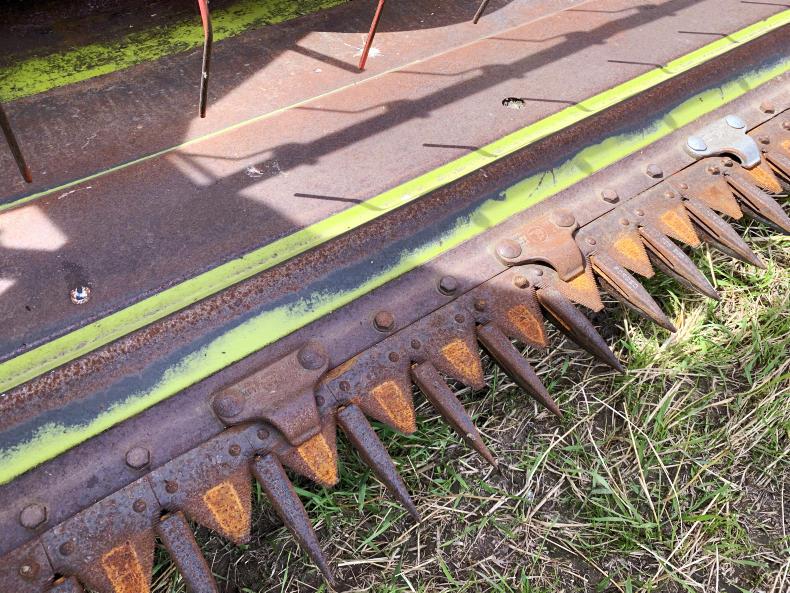
All knife sections should be present and sharp. Objects such as stones can easily damage these knife sections so daily routine checks are advised.
The combine’s sieves, grain tank and concave should be checked for damage and cleaned before the season starts. Spare parts such as knife sections, inlet fingers and elevator slats should all be kept in stock to save downtime in the event of a breakdown.
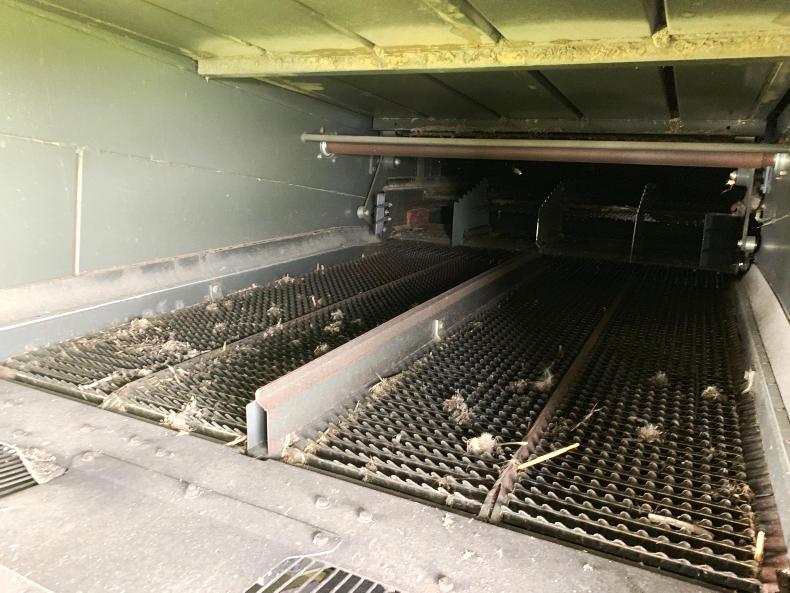
Sieves should be kept clean and checked regularly for foreign objects or damage.
Control terminals within the cab should be checked to ensure that sensors around the machine are reading correctly and are not faulty. No error codes should be present, but if they do appear, they must be investigated and rectified to reduce the chance of machine downtime.
Combines typically spend up to 10 months of the year stored away in a shed lying idle, before being worked to their limits for the duration of the harvest period.
Once harvest season starts these machines are expected to work optimally, while enduring the unpredictable Irish weather conditions. Given the intense harvesting period, reducing the possible risk of machine downtime is crucial, so it is important that these machines receive a thorough servicing from top to bottom well before entering the field.

Combines are often pushed to their limits throughout harvest season, so proper machine maintenance is key in ensuring a trouble-free season.
Breakdowns are impossible to eliminate no matter how new or how well maintained the machine is, but practising good, thorough machine maintenance before the season kicks off can greatly reduce the risk of downtime.
Operation
Today, there are mainly three combine types – straw walker machines, rotary machines and hybrid machines encompassing a mix of both technologies. Walker-type machines have evolved from the vintage stationary threshing sets, with the addition of a header, an engine, a transmission and a cab.
All manufacturers have different features and variations of the core design to make their own machines differ from the rest. All these machines are comparable in that they feature a header with a reel and knife auger. From here the auger feeds the elevator at rates up to 3m/s on modern machines, where the crop then enters the primary threshing/separator drum.

Auger fingers should be intact and not damaged or missing.
After passing through the primary threshing drum, the crop enters the secondary separator drum in many instances.
Combine types
Regardless of combine type, machines differ in how they separate the grains from the straw. Straw walker machines will separate them as the straw climbs the moving walkers. Straw is then ejected out the rear of the combine while grain falls onto sieves to be further cleaned. The shaker shoe separates the grains from the chaff using a fan to blow the light chaff out the rear of the machine, as the grain is transferred to the tank via elevator.
Rotary machines use centrifugal force to remove grains from the straw, so the more crop passing through the combine at any one time, the better the threshing, as the abrasive motion within the rotor removes grains. This is one of the main differences between walker and rotor machines, and a different mentality is needed when operating each one.
Regardless of brand, combines have a lot of moving parts, with multiple types of drive mechanisms. There are several kinds of chains and sprockets, and belts and pulleys using single, double-sided and multiple-banded belts.

The main pulleys internals here is designed to pull in air and cool the gearbox behind. Dust build up on this as can be seen will affect the cooling effcet.
Bearings and bushings also make up important parts of the machines.
Mechanisms such as slip clutches and hydraulic systems, hydrostatic drives and mechanical shaft drives all work to protect combine machines from overloading, with modern combines relying on more and more electronics such as sensors, solenoids and other electronic devices. And let’s not forget the engine, which can come from several different suppliers. All these individual components need to be maintained to a high standard.
Header and elevator
The header is the first point of contact with the crop, yet is often overlooked. If the header is not set up or properly maintained, this can be an area where losses occur, even before the crop enters the machine.

Headers often take abuse throughout the season so it is important everything is running as it should be.
The drive type, the header chain or belt drive condition and tension should be checked and maintained accordingly. It is a good idea to disconnect the knife bar from the wobble box and ensure it is moving freely and not bent.
If the knife bar is not moving freely, this can lead to damage within the wobble box over time, which creates the shearing-like reciprocating cutting motion. All knife sections should be intact and sharp, as blunt knifes will not cut the crop as clean, leading to loss of grain. Fingers should be in line and knife timing should be checked. Auger fingers located to the centre of the auger should be intact and not worn or missing.
Chaff should be removed from any electrical looms. This is a typical area vermin may target over the winter period and damage cables. All shafts and header connections should be greased daily and in good working order, and any bearings or wearing parts such as skids should be checked before the season starts.
The elevator
Elevator slats should be checked regularly and replaced if bent or damaged. Tension should be checked next; ideally the third bar in should be almost touching the elevator housing. Just below the elevator is the stone trap door, which ideally should be opened and emptied on a daily basis.

Stone traps should be emptied daily.
Engine and drivetrain
The engine should be serviced at the recommended intervals or annually. This includes diesel filters, oil filters, air filters, as well as daily checking of all fluid levels.

The engine should be fully serviced before the season. All filters should be changed, as dirty diesel filters for example can hinder engine preformance.
All drive pulleys and chains should be checked throughout for wear and tension, and tensioning or replacing should occur if necessary. These chains include grain tank elevator chains, return elevator chains and unloading system chains. Chains should be at the correct tension, the operator should be able to move the chain over and back on the sprocket, no tighter or no looser. It goes without saying that all chains and bearings should be receiving sufficient lubrication throughout the harvest period. The entire area should be blown down using an airline daily during the harvest, as dust and chaff build up easily during these dry dusty working conditions.

Combines should be blown down each evening or morning ahead of the next days work.
Some components or pulley wheels have an internal shape similar to a propeller to move air, and thus cool other components. These areas can build up with dust over time, and therefore need to be kept clean so that areas of the combine are receiving adequate cooling.
General maintenance
General machine maintenance such as checking the wheel or track condition, should be examined before harvest starts.

Combines fitted with tracks should be checked for wear and that track tension is as guided.
Tracked machines should have track tension checked and idler wheels given a once-over for excessive wear. Wheeled combines should be checked for cuts or damaged tyres, while wheel nuts should be torqued to manufacturers’ guidelines. Although chopping may have become less common, chopping units should still be serviced and at the ready. This means chopping knives should be sharp and replaced if broken or missing. Chaff spreaders should also be checked.

All knife sections should be present and sharp. Objects such as stones can easily damage these knife sections so daily routine checks are advised.
The combine’s sieves, grain tank and concave should be checked for damage and cleaned before the season starts. Spare parts such as knife sections, inlet fingers and elevator slats should all be kept in stock to save downtime in the event of a breakdown.

Sieves should be kept clean and checked regularly for foreign objects or damage.
Control terminals within the cab should be checked to ensure that sensors around the machine are reading correctly and are not faulty. No error codes should be present, but if they do appear, they must be investigated and rectified to reduce the chance of machine downtime.
















 This is a subscriber-only article
This is a subscriber-only article










SHARING OPTIONS: